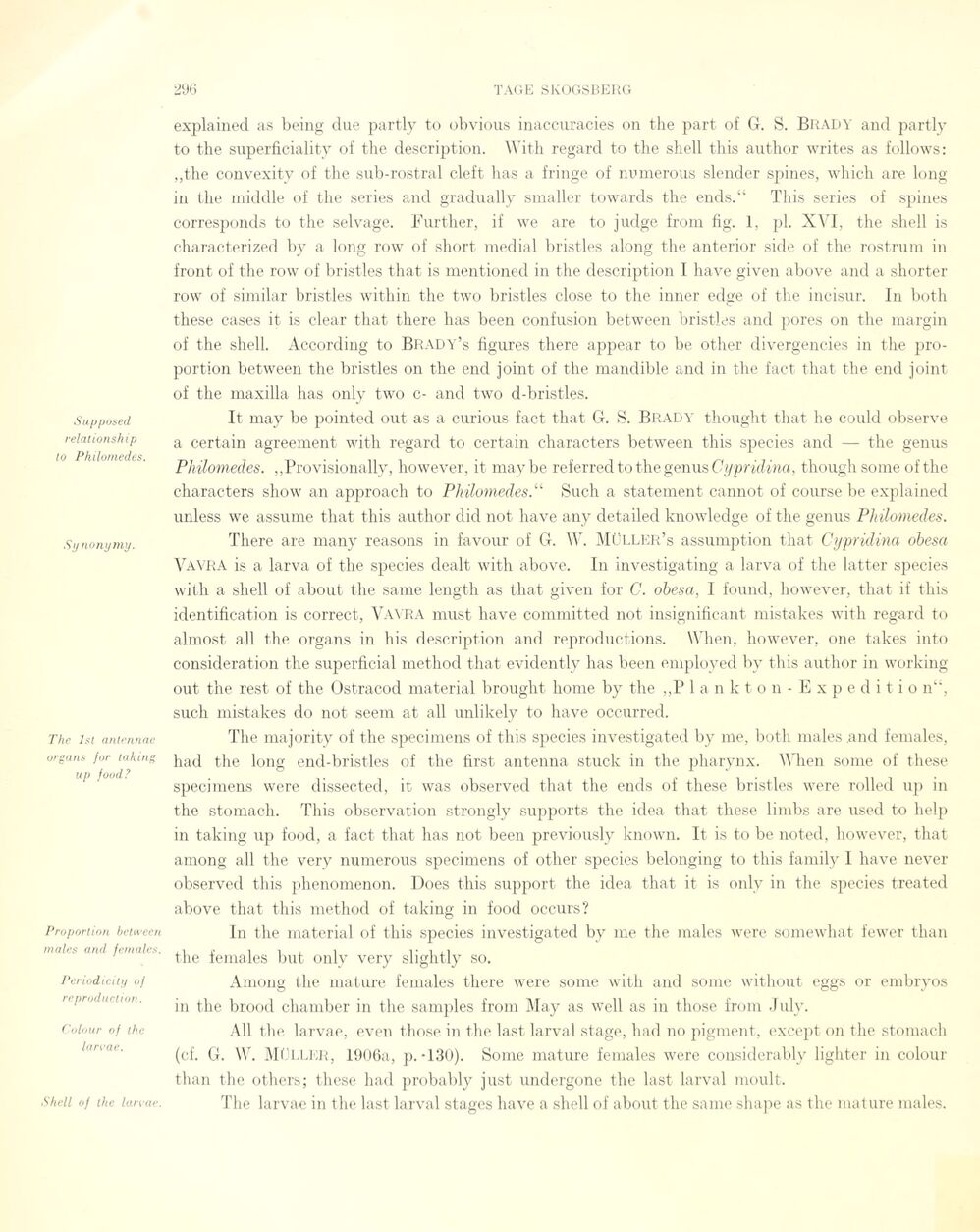
Full resolution (JPEG) - On this page / på denna sida - Sidor ...

<< prev. page << föreg. sida << >> nästa sida >> next page >>
Below is the raw OCR text
from the above scanned image.
Do you see an error? Proofread the page now!
Här nedan syns maskintolkade texten från faksimilbilden ovan.
Ser du något fel? Korrekturläs sidan nu!
This page has never been proofread. / Denna sida har aldrig korrekturlästs.
Supposed
relationship
to Philomedes.
Synonymy.
The Ist antennae
organs for taking
up food ?
Proportion between
males and fernales.
Periodieity oj
reproduction.
Colour oj the
larvae.
Shell oj the larvae.
explained as being due partly to obvious inaccuracies on the part of G. S. BRADY and partly
to the superficiality of the description. With regard to the shell this author writes as follows:
„the convexity of the sub-rostral cleft has a f ringe of nu mérous slender spines, which are long
in the middle of the series and gradually smaller towards the ends.“ This series of spines
corresponds to the selvage. Further, if we are to judge from fig. 1, pl. XVI, the shell is
characterized by a long row of short medial bristles along the anterior side of the rostrum in
front of the row of bristles that is mentioned in the description I have given above and a shorter
row of similar bristles within the two bristles close to the inner edge of the incisur. In both
these cases it is clear that there has been confusion between bristles and pores on the margin
of the shell. According to Brady’s figures there appear to be other divergencies in the
proportion between the bristles on the end joint of the mandible and in the fact that the end joint
of the maxilla has only two c- and two d-bristles.
It may be pointed out as a curious faet that G. S. Brady thought that he could observe
a certain agreement with regard to certain characters between this species and — the genus
Philomedes. „Provisionally, however, it maybe referred to the genus Cypridina, thoughsome ofthe
characters show an approach to Philomedes.“ Such a statement cannot of course be explained
unless we assume that this author did not have any detailed knowledge of the genus Philomedes.
There are many reasons in favour of G. W. Müller’s assumption that Cypridina obesa
Vavra is a larva of the species dealt with above. In investigating a larva of the latter species
with a shell of about the same length as that given for C. obesa, I found, however, that if this
identification is correct, VAVRA must have committed not insignificant mistakes with regard to
almost all the organs in his description and reproductions. When, however, one takes into
considération the superficial method that evidently has been employed by this author in working
out the rest of the Ostracod material brought home by the „Plankton- Expeditio n“,
such mistakes do not seem at all unlikely to have occurred.
The majori ty of the specimens of this species investigated by me, both males .and females,
had the long end-bristles of the first antenna stuck in the pharynx. When some of these
specimens were dissected, it was observed that the ends of these brist les were rolled up in
the stomach. This observation strongly supports the idea that these limbs are used to help
in taking up food, a fact that has not been previously known. It is to be noted, however, that
among all the very numerous specimens of other species belonging to this family I have never
observed this phenonienon. Does this support the idea that it is only in the species treated
above that this method of taking in food occurs?
In the material of this species investigated by me the males were somewhat fewer than
the females but only very slightly so.
Among the mature females there were some with and some without eggs or embryos
in the brood chamber in the samples from May as well as in those from July.
All the larvae, even those in the last larval stage, had no pigment, except on the stomach
(cf. G. W. Müller, 1906a, p. -130). Some mature females were considerably lighter in colour
than the others; these had probably just undergone the last larval moult.
The larvae in the last larval stages have a shell of about the same shape as the mature males.
<< prev. page << föreg. sida << >> nästa sida >> next page >>